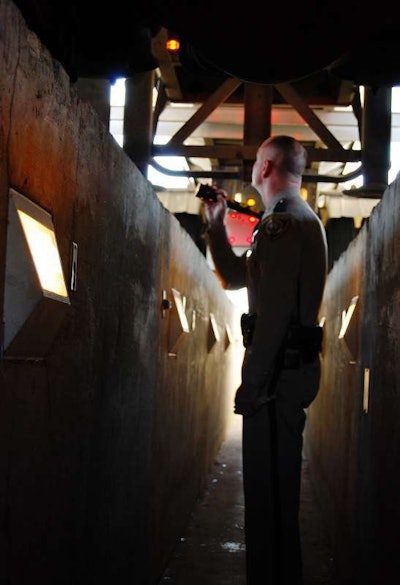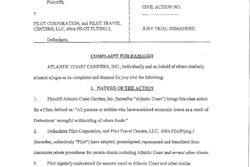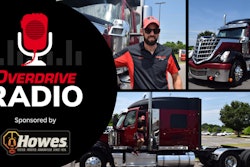
Bulldog Hiway Express President Phil Byrd, speaking as First Vice Chair of the American Trucking Associations, delivered a salvo aimed at the national focus on roadside vehicle inspections during an April 23 General Session of the Commercial Vehicle Safety Alliance’s workshop in Louisville, Ky.
To really improve safety, Byrd said, “We must be guided by what the data tells us,” namely that “87 percent of the crashes are the result of driver error or driver behavior.” Only 10 percent of crashes, he said, can be attributed to vehicle malfunction, 3 percent to environmental factors. “Examining driver credentials is not he best way of enforcing driver behavior,” he added, calling on a shift in focus away from roadside inspections at the state level to “on-road enforcement of traffic laws.
 Pointing to a slide display showing several of his Bulldog Hiway Express fleet trucks, “This represents trucks you don’t need to stop,” said Phil Byrd, getting a laugh from the assembled enforcement-community representatives at the CVSA Workshop in Louisville, Ky.
Pointing to a slide display showing several of his Bulldog Hiway Express fleet trucks, “This represents trucks you don’t need to stop,” said Phil Byrd, getting a laugh from the assembled enforcement-community representatives at the CVSA Workshop in Louisville, Ky.“Coupled with some inspection activities, [such robust enforcement] is four times more effective than roadside inspections – it makes sense for us to place far more emphasis of traffic enforcement.”
Byrd presented FMCSA’s own data to show the decline in traffic enforcement actions and the rise in inspection activity over many years. “There will be some of those who say a shift will cause equipment condition to slip,” he said, “but to those I say that focusing on traffic enforcement is an appropriate direction of our resources toward improving driver behavior.”

FMCSA Administrator Anne Ferro, however, appeared unfazed in her talk, which directly followed Byrd’s. In some sense, she said, she agreed with Byrd that a combination of robust traffic enforcement and inspections as necessary for public highway safety. Referencing 2011 fatal crash data Overdrive reported on showing a 20 percent increase “in the number of deaths of occupants of trucks,” she said, “one third [of the dead drivers] weren’t wearing seatbelts, and more than one in four were speeding. Speeding, seat belts, fatigue, all of these continue to be big actors in crashes…. High-visibility enforcement is a critical component of influencing behavior. High-visibility enforcement and taking conviction action is important to everything we do.”
“We are determined to get those bad actors off the road and out of the business. Gone are the days when folks could reincarnate, stick a few new DOT numbers in their pocket” and keep on running. —FMCSA Administrator Anne Ferro on ramped-up investigatory action at FMCSA in recent times, particularly on the bus side of the carrier population.
But so are roadside inspections, she added. Even the Driver Fitness Behavioral Analysis and Safety Improvement Category under the Compliance, Safety, Accountability regime, which has been shown not to correlate to carrier crash rates, can be utilized toward identifying unsafe carriers, Ferro said. “Three out of four [companies at alert status in that BASIC] also have an alert in another area. Compliance and accountability lead to safety, over and over again.”
Byrd also called on boosting education of and enforcement against the primary at-fault party in 70 percent of all truck-involved accidents. “Consider that 31 percent of traffic fatalities result from a driver impaired by alcohol,” Byrd said. “However, in only 2 percent of fatal truck crashes was the truck driver alcohol-impaired. Also, we know that younger drivers and older drivers have higher fatal crash rates than middle-agers. But they don’t drive trucks”as a general rule.
“Recognizing these statistics,” he added, “we must admit that focusing almost exclusively on the condition of trucks and the behavior of the truck driver will” be a mere drop in the safety bucket. “We must focus on the behavior of cars around trucks.”
EOBR update
Ferro updated CVSA attendees on the status of the electronic-log mandate Supplemental Notice of Proposed Rulemaking, the next step in FMCSA’s advancement of the mandate, codified into law with the MAP-21 highway bill last year. The SNPRM could be expected in September, she said, and the ultimate rule would do four things:
- Requires elogs for all truck and bus carriers using paper logs today
- Include provisions that prohibit the devices’ use for harassment
- Specify device technical standards
- Specify the required level of supporting document retention, which would be considerably lessened compared to the paper environment.
Medical certifications and the CDL
Ferro also detailed the three components of the agency’s ongoing “driver qualification loophole shutdown initiative,” as she dubbed agency efforts to crack down on fraudulent medical certifications.
- The concept of linking the medical certification to the Commercial Drivers License. “That’s in place today,” she said. “Most states have expanded their CDL/med cert efforts, but there are some states that haven’t gone far enough in enforcing that link between the CDL and the med cert.”
- The National Registry of Certified Medical Examiners. The requirement for any DOT physical to performed by an examiner who has undergone certification and is in the registry is coming in May 2014.
- Requirement for examiners to electronically trasmit medical certification information through FMCSA to the state of record when physicals are performed.











